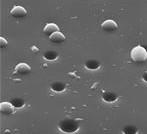Researchers at the University of Hull, UK, have developed a new self-assembly technique to make arrays of microlenses.
Researchers at the University of Hull, UK, have developed a new self-assembly technique to make arrays of microlenses.

These arrays of tiny lenses can project multiple images and are used in optoelectronic devices such as photosensors.
Using their own gel trapping technique, Vesselin Paunov’s group made polydimethlysiloxane (PDMS) surfaces and can control their microporous properties so that microlens arrays are made to order.
A layer of charged latex particles is spread at an oil-water interface and trapped by an aqueous gel. The oil is then replaced by PDMS, the latex particles are dissolved and the PDMS template is peeled off. The size and density of the micropores in the template are controlled by changing the number of trapped latex particles. The templates are then used to cast photopolymers to produce microlens arrays.
Changing the contact angle between the latex particles and the oil-water interface controls the lens’ focal length. In future the microlens’ size and shape may also be controlled.
Rebecca Lavender
References
O J Cayre and V N Paunov, J. Mater. Chem., 2004, 14, 3300 <MAN>b413361g</MAN>






No comments yet